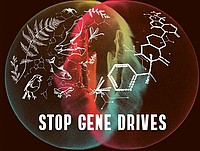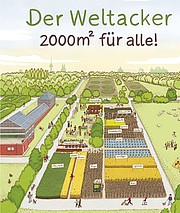As gene drives are in an early stage of development, the discussion about their possible consequences and risks is still largely speculative. However, numerous critical points are already emerging that need to be considered before a possible release.
Uncontrollability
Once released into the wild, a gene drive organism actively spreads in free-living populations and can spread rapidly over large distances. The vast diversity of natural habitats and ecosystems affected will make the prediction and control of potential risks massively more difficult. [+] more...
Irreversibility
A gene drive causes a permanent genetic modification of the genetic material, which is passed on to all subsequent generations. Even if a gene drive encounters resistance and no longer spreads under its own power, these changes could continue to be inherited according to Mendelian rules and persist for a long time in the genome of the population. Only if the deactivated gene drive severely impairs the survivability of the individuals do the mechanisms of natural selection take effect, which could eliminate the change in the natural populations again. [+] more...
Outcrossing across species boundaries
Gene drives are tailored to the genome of a single species, but in many cases outcrossing across species boundaries could be inevitable. For example, the malaria-carrying mosquito Anopheles gambiae belongs to a complex of seven different subspecies that are genetically very similar and can produce fertile offspring with each other.⁷ A gene drive by Target Malaria targets disruption of the gene Doublesex, which has undergone little change during the evolution of the mosquito species. This approach could drive all seven related mosquito species to the brink of extinction, although at least one species does not transmit malaria.⁸ [+] more...
Unexpected effects of CRISPR/Cas9
Many engineered gene drives use CRISPR/Cas9 to create a double-strand break at defined locations in the genome. However, this tool does not work flawlessly.¹⁰ CRISPR/Cas9 can change the activity of the target gene in unpredictable ways, increase the mutation rate in the genome, lead to unexpected mutations, or be disrupted in its function by emerging resistances. For example, there are increasing reports of so-called off-target effects, unintended changes to non-target sequences that can occur when the CRISPR/Cas system is applied.¹¹ [+] more...
Resistance
CRISPR-based gene drives search for a clearly defined DNA sequence at which they should cut the genome. Even single mutations in this sequence can therefore make the target invisible to them. The organism thus becomes resistant to the gene drive. Such resistance can arise when CRISPR/Cas9 itself generates mutations that destroy the target sequence. However, they could also occur naturally, especially in populations with high genetic diversity.
If a gene drive encounters resistance, it will stop at this point and only alter part of the population. However, whether it disappears completely depends on the number of individuals that have already been altered and the disadvantages that the gene drive has for their survival. It is therefore quite possible that the gene drive will continue to survive for a long time in an animal species despite resistance.
Unpredictable effects on ecosystems
Every living creature, even if it appears dangerous or harmful to humans, performs important tasks in its habitat. The extinction or even manipulation of one species will therefore have consequences for the entire ecosystem. [+] more...
Sources: [+] more...



